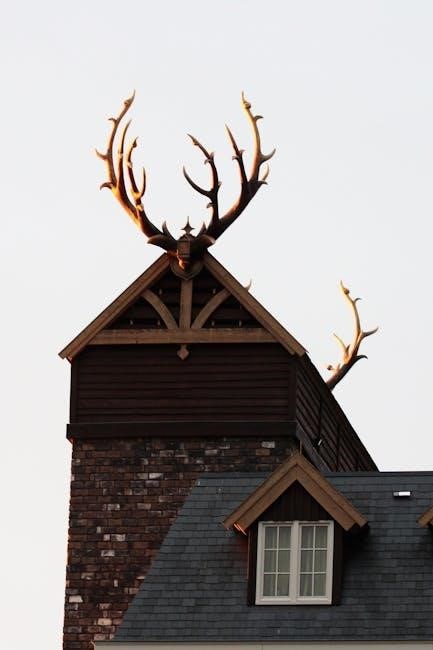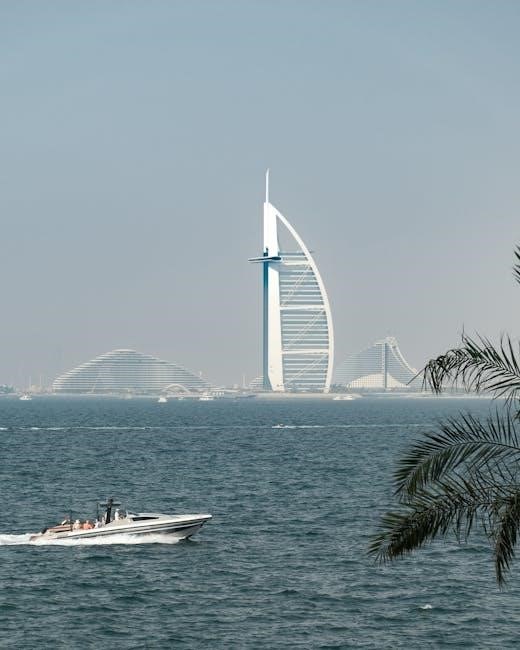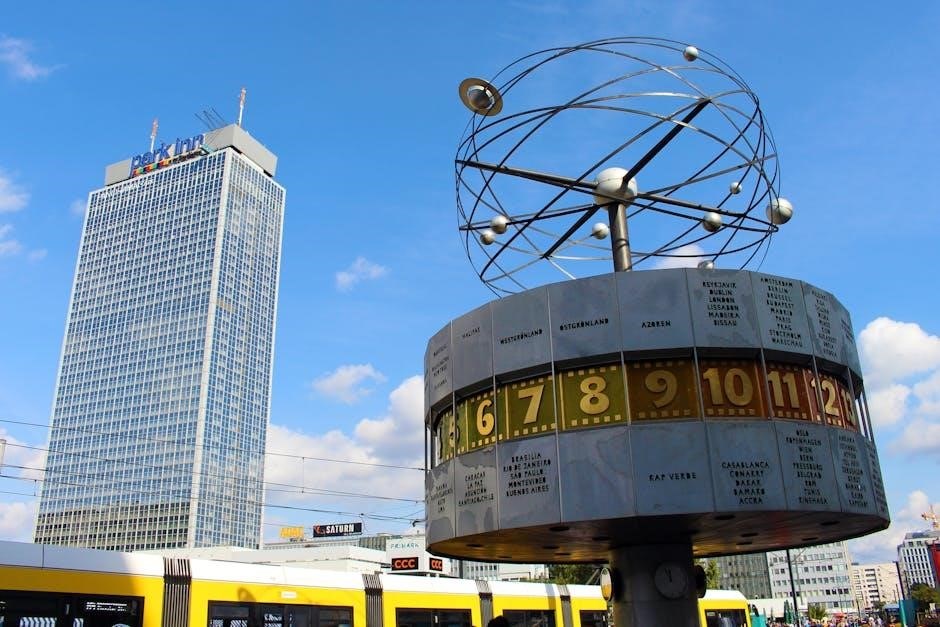Hotel Valhalla serves as a guidebook to Norse mythology, created by Helgi for guests. It covers gods, creatures, and the nine worlds, offering a humorous yet informative companion for residents preparing for Ragnarok.
Overview of Hotel Valhalla as a Guide to Norse Mythology
Hotel Valhalla serves as a comprehensive guide to Norse mythology, offering insights into the nine worlds, gods, mythical creatures, and legendary beings. Created by Helgi, the hotel manager, this guidebook is designed to help residents and guests navigate the intricate world of Norse lore. It features short entries on deities, mythical beings, and fantastical creatures, providing a humorous yet informative overview. The guide also includes bonus material, making it a valuable resource for understanding the structure of the Norse cosmos. Its purpose is to prepare guests, particularly the Einherjar, for their roles in Ragnarok, while also offering a entertaining and enlightening read.
The Role of Helgi, the Hotel Manager
Helgi, the manager of Hotel Valhalla, plays a crucial role in guiding guests through the realms of Norse mythology. With over a millennium of experience, he has curated a detailed guidebook to assist residents in understanding the nine worlds, gods, and mythical creatures. Helgi’s guide is both informative and engaging, offering insights into the complexities of Norse lore. His primary focus is to ensure that the Einherjar, Odin’s chosen warriors, are well-prepared for Ragnarok. Helgi’s dedication and expertise make him an invaluable resource for anyone navigating the fascinating yet intricate world of Norse mythology.
Structure and Purpose of the Guide
Helgi’s guide is a comprehensive companion for Hotel Valhalla residents, structured to introduce the nine Norse worlds and their inhabitants. It features concise entries on gods, mythical beings, and creatures, enriched with illustrations. Designed to prepare Einherjar for Ragnarok, the guide offers insights into Norse mythology while maintaining an engaging tone. Its purpose is to educate and entertain, serving as a vital resource for understanding the realms and their significance. This compact book is both a practical tool and a fascinating read, ensuring residents are well-informed and prepared for their roles in the impending battle.

The Nine Norse Worlds
Explore the diverse realms of Norse mythology, from Asgard’s divine halls to Helheim’s underworld, each with unique landscapes and inhabitants shaping the cosmic tapestry.
Asgard: Realm of the Gods
Asgard, the divine realm of the Aesir gods, shines with golden armor and gleaming halls. Odin, the All-Father, rules over this majestic domain, connected to Midgard by the rainbow bridge Bifrost. Home to Valhalla, where Einherjar train for Ragnarok, Asgard embodies strength and warrior spirit. Its inhabitants, including Thor and Freya, are central to Norse mythology. The realm’s beauty and power reflect the grandeur of the gods, making it a cornerstone of the cosmic structure described in Hotel Valhalla’s guide. Asgard’s splendor and significance are vividly portrayed, offering insights into the divine world’s wonders.
Midgard: The World of Humans
Midgard, the realm of humans, is surrounded by the vast ocean and encircled by the Midgard Serpent. It is the mortal world, connected to Asgard by the rainbow bridge Bifrost. Home to humans and their societies, Midgard reflects the duality of life and vulnerability. The gods often intervene here, influencing human affairs. As described in Hotel Valhalla’s guide, Midgard is a central world in Norse cosmology, representing the balance between order and chaos. Its significance lies in its role as the stage for human destiny, shaped by both mortal and divine forces.
Jotunheim: Land of the Giants
Jotunheim, the realm of the giants, is a harsh and rugged world inhabited by the Jotuns, ancient beings often at odds with the gods. Ruled by Thrym, it is a land of immense strength and primal power. The fortress Utgard stands as a testament to their might. Giants like Hrungnir and Skrymir embody the raw force of nature. Jotunheim’s icy landscapes and towering mountains reflect the chaotic essence of its inhabitants. While some giants ally with the gods, others remain enemies, contributing to the tensions between realms. This world of giants is a crucial part of Norse cosmology, shaping the balance of power in the nine worlds.
Svartalfheim: Realm of the Dwarves
Svartalfheim is the mysterious realm of the dwarves, master craftsmen renowned for their unparalleled skill in forging weapons and treasures. The dwarves, led by figures like Brok and Eitri, are known for creating legendary items such as Thor’s hammer, Mjolnir. Their expertise in metallurgy and craftsmanship is unmatched, shaping the destinies of gods and mortals alike. Svartalfheim’s dark, subterranean landscapes hide ancient secrets and treasures, reflecting the dwarves’ affinity for the earth and their reclusive nature. Despite their isolation, their creations play a central role in Norse mythology, influencing the balance of power in the nine worlds.
Niflheim: The Realm of Mist and Ice
Niflheim, the primordial realm of mist and ice, is a desolate and frigid land where the very essence of cold resides. Known as the birthplace of ice, it is one of the two primordial worlds in Norse cosmology. The rivers of Élivágar flow through Niflheim, forming the foundation of creation. This realm is a place of darkness and cold, contrasting sharply with the fiery Muspelheim. Niflheim’s icy expanse plays a crucial role in the cosmic balance, influencing the cycles of nature and the events leading to Ragnarok. Its frosty landscapes and mysterious origins are integral to the structure of the nine worlds.
Muspelheim: Land of Fire and Fire Giants
Muspelheim, the realm of fire, is a scorched and volcanic land inhabited by fire giants and their ruler, Surtur. Known for its intense heat and flames, it stands in opposition to Niflheim’s cold. This fiery domain is home to the dreaded fire giants, who play a pivotal role in Ragnarok. Surtur wields a massive flaming sword, and during the final battle, he will lead the assault on Asgard. Muspelheim’s fire and chaos are central to the end times, making it a key element in Norse eschatology. Its fiery essence and destructive power shape the destiny of the nine worlds.
Alfheim: Realm of the Light Elves
Alfheim is the radiant realm of the Light Elves, known for their beauty and magical abilities. This luminous world, one of the nine Norse domains, is characterized by its dazzling landscapes and harmonious environment. The Light Elves inhabit this paradise, living in synchronization with nature. Alfheim is often associated with the sun and purity, contrasting sharply with the darkness of Svartalfheim. Its inhabitants are revered for their wisdom and craftsmanship, contributing to the rich tapestry of Norse mythology. As a realm of light, Alfheim symbolizes hope and enlightenment, embodying the essence of divine harmony within the Norse cosmos.
Vanaheim: Realm of the Vanir Gods
Vanaheim, one of the nine Norse worlds, is the realm of the Vanir gods, known for their deep connection to fertility, wisdom, and magic. Inhabited by deities like Freya, Freyr, and Njord, this land embodies the forces of nature and prosperity. The Vanir, often associated with the earth and the cycles of life, bring balance and vitality to the cosmos. Their realm, rich in natural beauty, reflects their harmony with the environment. Vanaheim’s influence extends beyond its borders, shaping the prosperity of other worlds and the lives of gods and mortals alike in Norse mythology.
Helheim: The Underworld
Helheim, the Underworld, is a cold and grim realm ruled by Hel, Loki’s daughter. It is the final destination for those who do not die in battle, contrasting sharply with Valhalla’s glory. Described in the guide as a place of shadows and mist, Helheim embodies the darker aspects of Norse cosmology. Its eerie landscapes and somber atmosphere reflect the fate of those who reside there, far removed from the heroic afterlife of warriors. The guide highlights Helheim’s role in the balance of the nine worlds, emphasizing its significance in Norse mythology as a place of eternal rest and melancholy.

Key Figures in Norse Mythology
Explore the Aesir and Vanir gods, mythical beings, and important female figures shaping Norse mythology. The guide details their roles, stories, and influence in the nine worlds.
The Aesir and Vanir Gods
The Aesir and Vanir are two pantheons of Norse deities. The Aesir, led by Odin and Thor, reside in Asgard, governing war, wisdom, and lightning. The Vanir, including Frey and Freya, are associated with fertility and prosperity. These gods, once rivals, united after a historic war, blending their powers. Their stories, as recounted in Hotel Valhalla’s guide, highlight their complex relationships and roles in shaping destiny. The guide offers insights into their personalities, feats, and significance, making them relatable to modern readers.
Mythical Beings and Creatures
Norse mythology is rich with legendary beings, from the colossal wolf Fenrir to the Midgard Serpent Jormungandr. These creatures embody the chaotic forces of nature and the cosmic balance. Fenrir, destined to break free during Ragnarok, symbolizes destruction, while Jormungandr’s oceanic reign represents endless chaos. Other beings like Sleipnir, Odin’s eight-legged horse, and the fire giant Surtur highlight the diversity of Norse lore. Hotel Valhalla’s guide vividly portrays these beings, blending humor and intrigue to make their stories accessible and engaging for modern readers.
Important Female Figures in Norse Mythology
Norse mythology highlights powerful female figures who shape its narratives. Freyja, the goddess of love and fertility, leads the Valkyries and chooses half of those slain in battle. Her necklace Brisingamen symbolizes her divine allure. Hel, Loki’s daughter, rules Helheim, the underworld, embodying death and fate. Frigg, Odin’s wife, is the All-Mother, known for her wisdom and maternal care. These women wield significant influence, balancing power and vulnerability, and their stories are vividly portrayed in Hotel Valhalla’s guide, offering insights into their roles in shaping Norse cosmology and destiny.

Hotel Valhalla’s Facilities and Services
Hotel Valhalla offers unique facilities tailored for Einherjar, including special accommodations, training areas for battle preparation, and access to cultural resources for understanding Norse mythology.
Accommodation for Einherjar
Einherjar, chosen warriors of Odin, find their home at Hotel Valhalla. The hotel provides special accommodations designed to meet their unique needs, ensuring comfort and readiness for battle. Each room is tailored to reflect the honor and valor of its inhabitants, offering a blend of Norse-inspired decor and modern amenities. The accommodations are not just a place to rest but also a symbol of their esteemed role in the impending battle of Ragnarok, fostering camaraderie among the warriors as they prepare for their destiny.
Training and Preparation for Ragnarok
Hotel Valhalla offers comprehensive training programs for Einherjar, preparing them for the epic battle of Ragnarok. Under the guidance of seasoned warriors and gods, residents engage in rigorous combat exercises, strategy sessions, and tactical drills. The hotel’s facilities include battle simulators, weapon forges, and ancient rune-filled libraries to enhance their skills. Mental and physical preparation are emphasized, with a focus on unity and teamwork. These training sessions are crucial for the Einherjar to face the coming apocalypse, ensuring they are battle-ready to defend the realms alongside the gods in the final confrontation.
Cultural and Mythological Resources
Hotel Valhalla provides an extensive collection of cultural and mythological resources, offering guests a deep dive into Norse mythology. The library contains ancient texts, scrolls, and runic inscriptions detailing the histories of gods, giants, and mythical creatures. Guests can explore the Nine Worlds through meticulously crafted maps and visual guides. Additionally, the hotel hosts regular lectures and storytelling sessions led by experienced skalds, preserving the rich cultural heritage of the Norse realms. These resources not only educate but also inspire, helping residents connect with their roles in the impending events of Ragnarok.

Magical Creatures and Beings
The guide explores the diverse array of magical creatures and beings in Norse mythology, from towering giants to mischievous dwarves, highlighting their roles in the cosmic landscape.
Fenrir, Jormungandr, and Other Monsters
The guide delves into the fearsome monsters of Norse lore, including Fenrir, the giant wolf, and Jormungandr, the Midgard Serpent. These beings, destined to play key roles in Ragnarok, are explored in detail. Fenrir, bound by the gods, is a symbol of chaos and destruction, while Jormungandr encircles Midgard, representing the ocean’s vastness. Other monstrous figures, such as Hel, the ruler of the underworld, and Nidhöggr, the dragon gnawing at Yggdrasil, are also highlighted; These creatures embody the dark forces that the einherjar will face in the final battle, making them central to the guide’s narrative.
The Role of Loki in Norse Mythology
Loki, the god of mischief and trickery, plays a pivotal role in Norse mythology. Known for his cunning and unpredictable nature, he often challenges the gods, walking a fine line between ally and adversary. Loki’s antics, while sometimes helpful, frequently lead to chaos and conflict. His offspring, including Fenrir and Jormungandr, are central to the events of Ragnarok. Despite his troublesome reputation, Loki’s cleverness and wit make him a fascinating figure. His ultimate betrayal and punishment underscore the complexities of his character, making him a key subject in Hotel Valhalla’s guide to the Norse worlds.
Dragons and Serpents in Norse Lore
Dragons and serpents hold significant roles in Norse mythology, often symbolizing chaos and destruction. Jormungandr, the Midgard Serpent, encircles the world, while Nidhöggr gnaws at the roots of Yggdrasil. Fafnir, a dwarf turned dragon, guards treasure and embodies greed. These creatures are tied to Ragnarok, where they will unleash havoc. Hotel Valhalla’s guide highlights their importance, detailing their origins and roles in Norse cosmology. Their stories illustrate the delicate balance between order and chaos, making them essential figures in the guide to the Norse worlds.

Preparation for Ragnarok
Hotel Valhalla readies warriors for Ragnarok, the final battle. Einherjar train relentlessly, honing skills to face cosmic foes. The guide details their roles and the impending destiny.
The Significance of Ragnarok
Ragnarok, the end of the world in Norse mythology, signifies a catastrophic yet transformative event. It foretells the fall of gods like Odin and Thor, the release of monstrous beings, and the world’s rebirth. Hotel Valhalla prepares warriors for this final battle, emphasizing its inevitability and the roles of Einherjar. The guide highlights Ragnarok’s dual nature—destruction and renewal—underscoring its importance in the cosmic cycle. This prophecy-driven event shapes the purpose of Hotel Valhalla, uniting its residents in a shared destiny to fight alongside the gods.
The Role of Einherjar in the Final Battle
The Einherjar, chosen warriors of Odin, play a pivotal role in Ragnarok, fighting alongside the gods against monstrous forces. Selected from battlefields, they reside in Hotel Valhalla, training and preparing for the final conflict. Their bravery and strength are crucial in the impending clash, as they embody the last defense against chaos. The guide highlights their unity and purpose, emphasizing their importance as heroes who will shape the outcome of the end times. Their story is one of honor, sacrifice, and destiny, central to the legacy of Norse mythology and the battles foretold in prophecy.
Prophecies and Omens
Prophecies and omens are central to the unfolding of Ragnarok, as foretold by the Norns and Odin. The breaking of bonds, the release of Fenrir, and the trembling of Yggdrasil signal the end. Hotel Valhalla prepares its residents by deciphering these signs, ensuring the Einherjar are ready. The prophecies highlight the inevitability of the final battle, with fire and ice engulfing the worlds. Through these omens, the guide underscores the importance of unity and preparation, as the fate of the realms hangs in the balance. The intertwining of destiny and free will shapes the warriors’ resolve for the ultimate confrontation.

Magnus Chase’s Perspective
Magnus Chase, a modern demigod, shares his humorous and relatable experiences as a resident of Hotel Valhalla. His perspective offers insights into the challenges of being a contemporary warrior, blending witty storytelling with the rich tapestry of Norse mythology, making the guide both entertaining and enlightening for its readers.
Experiences as a Resident of Hotel Valhalla
Magnus Chase’s life transformed when he became an Einherjar, a warrior chosen by Odin. As a resident of Hotel Valhalla, he navigates a world of Norse mythology, encountering gods, giants, and mythical creatures. Once a homeless teen surviving Boston’s streets, Magnus now faces challenges of a divine scale. The guidebook, filled with humorous insights and stories, becomes his trusted companion. Helgi’s creation helps him understand the nine worlds and prepare for Ragnarok. Magnus’s perspective blends wit with courage, offering a relatable lens into the extraordinary world of Hotel Valhalla and its purpose.
Challenges Faced by Modern Demigods
Modern demigods, like Magnus Chase, face unique struggles blending mortal life with divine responsibilities. Surviving on the streets of Boston, Magnus relied on wit and cunning, skills that now aid him in Valhalla. Balancing human instincts with the expectations of being an Einherjar proves daunting. The pressure to prepare for Ragnarok while navigating the complexities of Norse mythology adds to the burden. Magnus’s journey highlights the challenges of adapting to a world far removed from his urban upbringing, yet his resilience and humor shine through, making him a relatable figure in this extraordinary realm.
Humor and Storytelling in the Guide
The guide is infused with humor, as Rick Riordan’s signature wit brings Norse mythology to life. Magnus Chase’s sharp observations and humorous retellings of mythological tales make the guide engaging. Loki’s antics and the quirky personalities of gods and creatures add comedic relief, while maintaining the richness of the myths. The storytelling seamlessly blends modern humor with ancient legends, making the guide relatable and entertaining. This approach ensures that even the most complex aspects of Norse mythology are presented in an accessible and enjoyable way, reflecting Magnus’s own journey and perspective as a modern demigod.